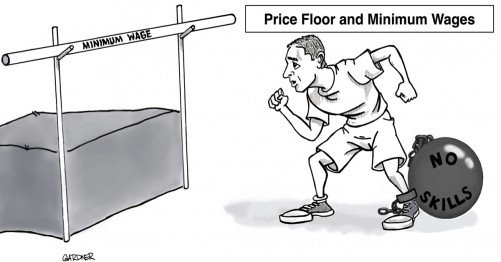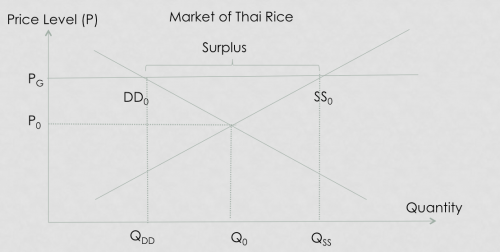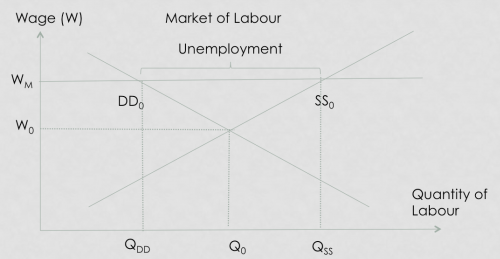Have you ever wondered how is it possible to have a “floor” on price on any goods?
Well first of all, price floor exist because of government intervention in the free market. In this case, the government deems that the market equilibrium price is determined way too low and decides to impose a “floor” on the price that they want to set, making sure that the government determined price PG will not fall below the market equilibrium price at P0 (floor literally meaning nothing can go beyond it):
In the scenario of Thai rice, when PM Yingluck Shinwatra (now facing trial) took over powers in Thailand 2011 General Election, one of her populist votes is to offer rice farmers income protection. How is income protection related to price floor? So initially, supposing the Demand and Supply of Thai Rice is at equilibrium at P0 and Q0. The Thai government announced that a price floor of PG will be imposed on top of P0. The price floor artificially raised price of rice from $271/ton (P0) in July 2011 to $500/ton (PG) in September 2011. At PG, there will be a surplus of rice where quantity supplied by thai farmers is greater than quantity demanded by Thai consumers / the rest of world.
The surplus of rice will then be purchased by the Thai Government at inflated PG, thus, providing an implicit income guarantee and subsidy for rice farmers. How does it impact Thai Economy?
- Food inflation – as rice is a staple food in Asia and Thailand is a major exporter of rice (besides Vietnam), core inflation is bound to rise. Besides, if consumers switch to other forms of staple consumption, excessive switch in consumption habits to noodles will also cause price of noodles to raise;
- Income distortion – as you can see, the Thai Government has to channel resources from other sectors like education to provide subsidy for the Thai farmers. Income of Thai farmers is artificially inflated at the expense of other sectors of the economy;
- Strained on fiscal budget – if the Thai Government could no longer channel resources from other sectors, it will have to deep into its own coffers to provide this “price guarantee” to rice farmers, further worsening its fiscal position for rainy days.
From this example, we can see that politics and economics are closely related. In order to win votes, there are many tools available to a politician to use, and price floor is not necessary one of them. However, not every tools politicians use are of the best interest of the economy!
Another popular yet similar variation of a price floor is a minimum wage:
Like price floor, the government intervenes in the labour market and imposes a higher wages at Wm instead of the equilibrium price at W0. Unemployment occurs at the gap between amount of labour demanded QDD and amount of labour supplied QSS and can be broken into two parts:
- From QDD to Q0, employers (who form the demand for the labourers) will cut back on employment due to higher business cost.
- From Q0 to QSS, more workers would be attracted into the job market due to higher wages at Wm.
A popular example would be the recent wage mandatory wage hike for MacDonald’s in the US. Here are some points to note:
- Redistribution of income – The purpose of wage hike is normally to protect low income earners from high living cost and equalise the income inequality condition in the host country by forcing employers to bear the higher labour cost;
- There is always a tradeoff – to ask for higher wages, the economy will have to accommodate some level unemployment. And in this scenario, opportunity cost of being unemployed means that human resources in the country will be under utilised;
- Anti-business sentiment – small businesses, especially MNCs, will be wary to set up investments in the host country if the host government implements such “anti-business” regulation as this raises labour costs of business. This is why Singapore will never have such regulation as we are very dependent on Foreign Direct Investment “FDI“;
- Wage push inflation – Higher labour cost will normally translate into higher cost push inflation in an economy.
In my classes, I will be regularly referring to real life examples to relate to complicated diagrams like this. If you find this article interesting and easy to digest, please consider my regular classes and let me help you to score your A in Econs!
[aio_button align=”center” animation=”none” color=”blue” size=”small” icon=”none” text=”JC Econs & Schedule” relationship=”dofollow” url=”https://aceyourecons.sg/jc-economics/”]
[aio_button align=”center” animation=”none” color=”red” size=”small” icon=”none” text=”Poly Econs” relationship=”dofollow” url=”https://aceyourecons.sg/poly-economics/”]
[aio_button align=”center” animation=”none” color=”green” size=”small” icon=”none” text=”Related Topic – Price Ceiling” relationship=”dofollow” url=”https://aceyourecons.sg/topical-summary-price-ceiling/”]
[aio_button align=”center” animation=”none” color=”orange” size=”small” icon=”none” text=”Back to Home” relationship=”dofollow” url=”https://aceyourecons.sg/”]



